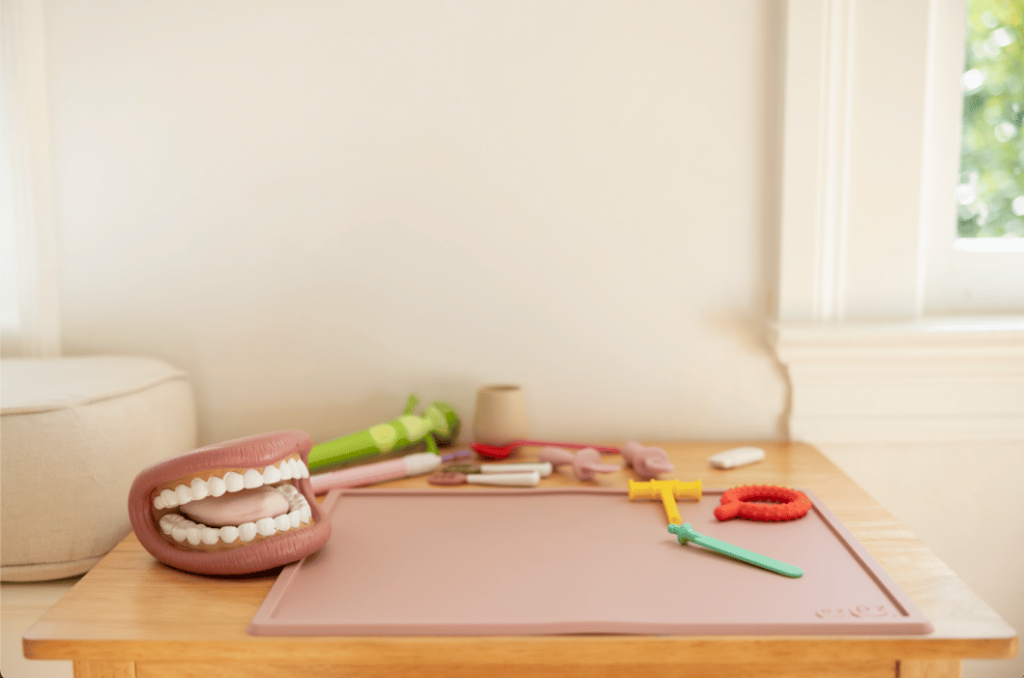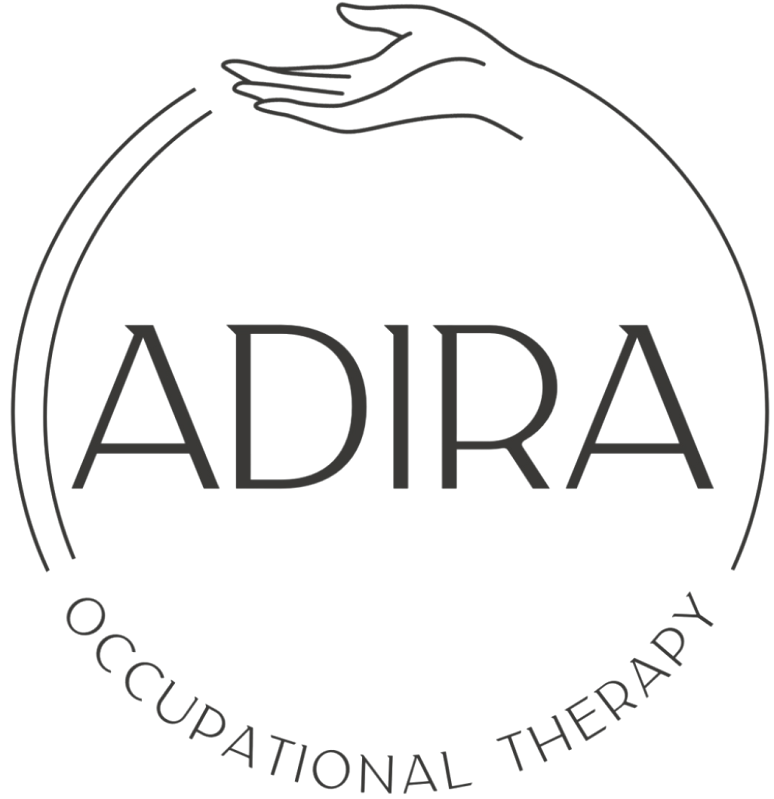The Oral Motor Tool Guide: Recommendations for Toys, Utensils, and More. This post is for informational and general purposes only and is not meant to replace individualized advice or Occupational therapy services.
Disclaimer: This post contains affiliate links. If you click on these links and make a purchase, I may earn a small commission at no additional cost to you.
As a mama and pediatric occupational therapist specializing in feeding and oral motor support, specifically tethered oral tissues, I often get asked about the best tools and toys for promoting oral motor development in kiddos. The oral motor tool guide aims to provide parents and caregivers with practical recommendations and insights into the significance of oral motor exploration and proper oral rest posture.
Oral rest posture refers to the tongue, lips, and jaw position when the mouth is at rest. A proper oral rest posture is essential for breathing, facial development, and sleep.

The Importance of Oral Motor Exploration
Oral motor exploration is a critical aspect of your kiddo’s development. From the moment babies are born, they begin to explore their world through their mouths. This exploration is not just about tasting and chewing; it plays a crucial role in developing essential skills such as regulation, feeding skills, oral rest posture, and sensory processing.
Feeding Skills
- Chewing (Phasic Bite): Efficient chewing is fundamental for safe and effective eating.
- Texture Acceptance: Exposure to different textures helps children accept a variety of foods, preventing picky eating habits.
Oral Rest Posture
- Breathing: Encourages nasal breathing, which is healthier than mouth breathing.
- Facial Development: Supports the proper development of facial structures and muscles.
Infant Feeding and Oral Motor Developmental Milestones
- 0-3 Months:
- Reflexive sucking and swallowing.
- Opens mouth and moves head towards the nipple or bottle.
- Tongue movement is primarily reflexive.
- 3-6 Months:
- Begins to put hands and toys in mouth.
- Starts to suck on fingers and fists.
- Gains better control over sucking and swallowing.
- 6-9 Months:
- Begins to chew with an up-and-down jaw movement.
- Starts to experiment with different textures and tastes.
- 9-12 Months:
- Improved coordination of chewing and swallowing.
- Begins to feed themselves with finger foods.
Recommended Tools and Toys
Here are some of my top recommendations for tools and toys that can help promote healthy oral motor development. I typically recommend introducing oral motor toys when Bebe can grasp and bring them to their mouth independently at about three months. The recommendations are listed in no particular order and are not exhaustive.
Teethers, Toys, and Utensils
Chewable Teethers
What: Soft, safe, and textured toys designed to practice chewing.
Why: They provide sensory input, give feedback to the brain, help strengthen the jaw and tongue, and facilitate pre-feeding skills. Oral motor toys and teethers should be strong enough to provide resistance.
- EZPZ Oral Development Tools
- Innobaby Original Teethin Smart EZ Grip Fruit Teether and Sensory Toy for Babies and Toddlers
- Innobaby Original Teethin Smart EZ Grip Star Teether and Sensory Toy for Babies and Toddlers
- haakaa 360° Baby Toothbrush with Suction Base – Gentle Cleaning for Infant Self-Brushing Training, Food-Grade Silicone, Adjustable Safety Shield
- Comotomo Silicone Baby Teether
- Chewy Tubes Knobby P’s in a Pod – 2 Green Knobby P’s Oral Sensory Mouth Exerciser Teether
- Bright Starts Oball Shaker Rattle Toy, Ages Newborn Plus
- Bright Starts Oball Easy-Grasp Rattle BPA-Free Infant Toy in Teal, Age Newborn and up, 4 Inches
- Nuby 100% Silicone Tuggy Teether Ball
Infant Spoons with Textured Handles
What: Spoons designed with small textured handles.
Why: They encourage self-feeding and provide sensory input to the lips and mouth.
Straw and Open Cups
What: Cups with silicone straws intended for littles.
Why: Using a straw or open cup helps strengthen the lips, cheeks, and tongue.
- NumNum Baby Spoons Set, Feeding Littles x Silicone Pre-Spoon GOOtensils for Kids Aged 6+ Months – First Stage, Baby Led Weaning (BLW), Teething Spoon – Toddler Utensils – 3 Spoons, Neutrals
- TalkTools ITSY Tiny Silicone Spoons – Twin Pack Soft Silicone Self-Feeding Training Spoons for Kids & Toddlers
- ezpz Tiny Collection Set
- ezpz Tiny Spoon
- ezpz Tiny Bowl
- Bumkins Baby Utensils Set, Chewtensils Silicone Spoons for Dipping, Self-Feeding, Baby Led Weaning, Trainer Learning, First Stage Eating, Soft Practice Fork and Spoon, Babies 6 Months
- Special Supplies Honey Bear Straw Cup
- GROSMIMI Spill Proof no Spill Magic Sippy Cup with Straw with Handle for Baby and Toddlers
- Olababy Silicone Training Cup with Straw Lid | Babies Water Drinking Cup
- ezpz Tiny Cup
- ezpz Mini Cup + Straw Training System
- BUSY BABY Silicone Mat – Suction Cups, 4 Straps to Secure Baby Essentials, Self Feeding, Baby Led Weaning, Travel Sleeve Included
- ezpz Tiny Placemat – 6 Months+
- ezpz Tiny Pops (Pewter) – Popsicle Mold Set with Wands for Infants 4 Months +
- ezpz Tiny Collection Set (Gray) – 100% Silicone Placemat, Cup & Spoon for First Foods + Baby Led Weaning + Purees – Designed by a Pediatric Feeding Specialist – 6 Months+
Oral motor exploration is vital to a child’s development, impacting their ability to speak, breathe, eat, and maintain proper oral rest posture. By integrating appropriate tools and toys into their daily routines, parents and caregivers can promote optimal oral motor development and assist their kiddos in reaching important developmental milestones.
Remember, each kiddo is unique, and choosing tools and toys that match their needs and preferences is essential. If you have concerns about your child’s oral motor development, consider consulting an occupational therapist for personalized guidance and support.
Thanks for being here!
Click here for Part Two of The Oral Motor Tool Guide: Recommendations for Toddlers
